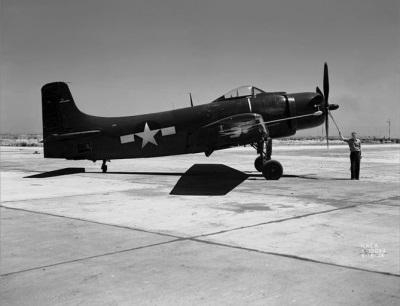'Spad' To Go On Display At The Intrepid Sea, Air And Space Museum
For more than 40 years, NAS Oceana has been home to a prototype of the famous A-1 Skyraider series of attack bombers. Nicknamed "Spad," this particular airplane was the XBT2D-1 Dauntless II.

Last painted in the colors of the "Valions" of Attack Squadron 15, (now Strike Fighter Squadron 15), which flew the AD-4 Skyraider from 1949 to 1965, the Skyraider has served as the backdrop for many photos by visitors to Oceana. But on May 15, after a week of careful dismantling, the Spad left its longtime home at the Aviation Historical Park and was transported to the Intrepid Sea, Air and Space Museum in New York City, where museum staff inspected the aircraft and carefully re-assembled it.
"To have this airplane on the Intrepid is a very big deal because it is beautiful and is very relevant to the Intrepid's history," said Peter Torraca, aircraft restoration and interpretation specialist for the museum. "It has performed a lot of duty on the Intrepid during its time in service."
For the first time in many years, the Spad from Oceana returned to the flight deck of a ship on May 20, and fittingly it returned to the aircraft carrier where it once made history. Using a large crane and sturdy cables, the Skyraider was hoisted high above the ship and gently set down on Intrepid's flight deck, where visitors to the museum will have the opportunity to see a piece of aviation history.
"It's sad to see the Spad go, but we recognize that all the aircraft in the park are an important part of Navy and Marine Corps aviation and deserve to be in a place where they will reach the best audience. The Intrepid Museum is the best place for that aircraft," said NAS Oceana Commanding Officer Capt. Kit Chope about the aircraft's departure from the base.
Of the 13 aircraft in the Aviation Historical Park at Oceana, three, including the Skyraider, were on loan from the National Museum of the Marine Corps in Quantico, Va. The remaining 10 at Oceana are on loan from the National Naval Aviation Museum in Pensacola, Fla.
After an inspection, representatives of the Marine Corps museum determined age and the elements were taking their toll on the Skyraider airframe. It was decided the airplane should be moved to a place that can repair and perform the proper preservation work, according to a release from the Intrepid Museum.
Beginning on May 7 and over the course of several days, Worldwide Aircraft Recovery, Ltd. disassembled the Skyraider and shipped it to its new home aboard USS Intrepid (CV 11), the decommissioned aircraft carrier which is the foundation of the museum complex.
Following its arrival in New York, representatives of the museum evaluated the condition of the Skyraider for possible restorations needed to maintain the appearance of the plane.
"Between the disassembling and reassembling of the airplane, I will determine which parts and components need to be left off so we can do restorations," said Torraca.
Marty Batura, vice president of Worldwide Aircraft Recovery, has been transporting aircraft for 17 years. The three crew members who disassembled the Skyraider all work for the company and together transport between 40 - 80 aircraft a year.
"Being a part of all of this is what I really love. We transport a lot of trainer aircraft, which are training military members today. There is a lot of hard work and long hours, but when we accomplish our mission, that's what it is all about for me. Ninety percent of our business is, in one way or another, interactive with the military, whether it is transporting aircraft to a museum or base to base," Batura said.
"Coming here to Oceana, we have been made to feel very welcome, no issues. Everybody is more than supportive to make this happen and it is really a pleasure to work here," Batura added.
According to the museum's press release, Skyraiders are rare. Only approximately 57 are still known to exist and of those, only about 20 are still flyable.
The XBT2D-1 was a prototype designed by the Douglas Aircraft Company. It made its first flight in March and after evaluation, the aircraft was delivered to the Navy in late 1946 and designated the AD-1.
Although not in production to help the war effort during World War II, the carrier-based dive-bomber flew missions in the Korean War and North Vietnam until leaving active service in 1971. It had a wingspan of 50 feet and a maximum speed of 195. Eventually 3,180 Skyraiders in several configurations were built. They served not only the U.S. Navy and Marine Corps, in both the Korean War and Vietnam War, but also with the U.S. Air Force and with 10 other nations.
One of the Skyraider's proudest moments occurred on Oct. 9, 1966. While flying a Skyraider off Intrepid, Lt. j.g. William T. (Tom) Patton (no relation, ed.) shot down a MiG-17 over Vietnam. The Skyraider was not designed to be a dogfighter, so air-to-air combat was very rare. A victory in which a propeller-driven airplane prevailed over the jet-powered MiG-17 was an unusual occurrence.
(Public domain image of representative aircraft provided by National Advisory Committee for Aeronautics [NACA])
 ANN's Daily Aero-Term (04.24.24): Runway Lead-in Light System
ANN's Daily Aero-Term (04.24.24): Runway Lead-in Light System ANN's Daily Aero-Linx (04.24.24)
ANN's Daily Aero-Linx (04.24.24) Aero-FAQ: Dave Juwel's Aviation Marketing Stories -- ITBOA BNITBOB
Aero-FAQ: Dave Juwel's Aviation Marketing Stories -- ITBOA BNITBOB Classic Aero-TV: Best Seat in The House -- 'Inside' The AeroShell Aerobatic Team
Classic Aero-TV: Best Seat in The House -- 'Inside' The AeroShell Aerobatic Team Airborne Affordable Flyers 04.18.24: CarbonCub UL, Fisher, Affordable Flyer Expo
Airborne Affordable Flyers 04.18.24: CarbonCub UL, Fisher, Affordable Flyer Expo



